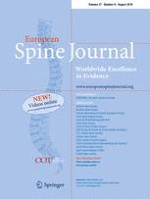Published in:

01-08-2018 | Original Article
Relationship between sagittal spinal curves geometry and isokinetic trunk muscle strength in adults
Authors:
Walaa Elsayed, Ahmed Farrag, Qassim Muaidi, Nora Almulhim
Published in:
European Spine Journal
|
Issue 8/2018
Login to get access
Abstract
Purpose
Sagittal spinal deviation has been reported to be a significant musculoskeletal problem affecting both genders and could develop at any age. Factors triggering this issue are still not well defined. The purpose of this study was to investigate the relationship between sagittal spine angles and isokinetic peak, average torque, and power of trunk muscles in asymptomatic adults.
Methods
A convenient sample of 79 subjects with asymptomatic spine participated in this study. Thoracic and lumbar curves angles were measured using the Formetric 4D device. Thoracolumbar (T/L) ratio was calculated as an indicator of spine balance. Isokinetic peak and average torque and average power for trunk flexors and extensors were measured at 60°/s in seated and semi-standing test positions.
Results
Lumbar curve angle was moderately inversely correlated (p < 0.001) with peak extension torque (ρ = − 0.532 and − 0.495 in seated and semi-standing positions, respectively) and peak flexion torque (ρ = − 0.604 and − 0.542 in seated and semi-standing positions, respectively). The T/L ratio was found to be significantly associated (p < 0.001) with trunk extension torque (ρ = 0.422 and 0.378 in seated and semi-standing positions, respectively) and trunk flexion torque (ρ = 0.396 and 0.321 in seated and semi-standing positions, respectively). Similarly, average torque and power measurements were significantly correlated with lumbar curve angle and T/L ratio.
Conclusions
Sagittal spine balance is associated with trunk muscles strength in adults, particularly, the lumbar spine muscles. Therefore, assessment of sagittal spinal balance and trunk muscles strength should be taken into consideration when designing rehabilitation programs for correction of sagittal spine curvature.